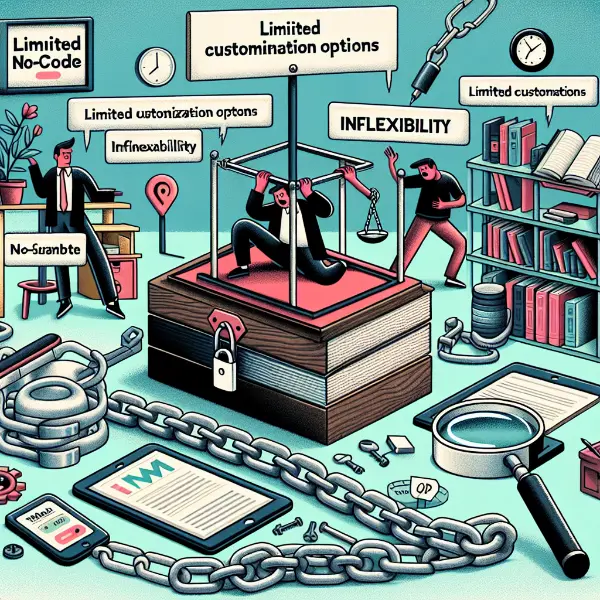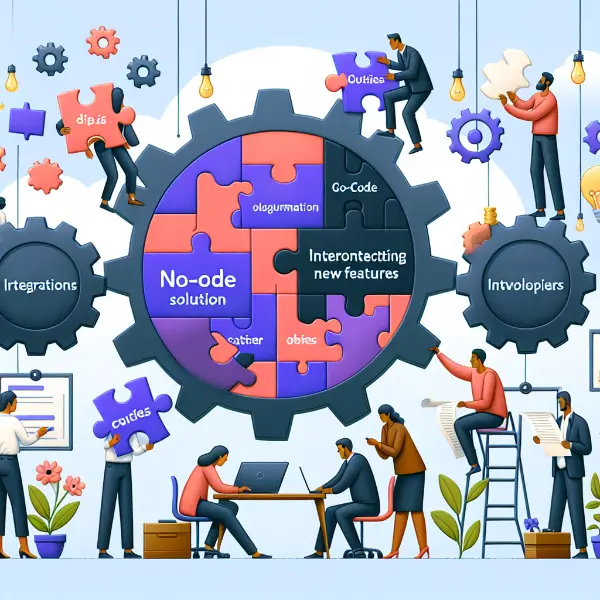Rise of No-Code Platforms and Their Appeal

Essentially, these intuitive platforms have quite single-handedly disrupted the tech setup, making the entrepreneurial dream accessible to more than just the anointed few. Perhaps the most appealing feature is the immediate cost-saving advantage. Let’s take a moment and delve into this – imagine you’re a bootstrapped start-up. Your budget is tight or maybe even barely existent. You need a website, an app, a CRM, or some fancy automation, but you don’t have the resources to hire an army of software engineers. This is the precise gap that no-code platforms, with their 50% to 70% reduction in development costs, are skillfully bridging – fundamentally democratizing the process.
The user-friendliness of these platforms is another key factor contributing to this growing trend. For long, technical skills were seen as the gatekeepers to the world of innovative solutions. No-code platforms, however, have kicked down that gate, making technology less about coding and more about instinctive creativity. You don’t need to be fluent in Python or Java anymore; if you can navigate MS Excel, handle project management apps, or even make compelling PPTs, you’ll find yourself at home with no-code platforms.
In essence, no-code platforms aren’t just a trend because they’re fresh and exciting, they’re a disruptive force in the tech industry because they solve pervasive pain points. They offer non-tech entrepreneurs the freedom to build without borders or bottlenecks. No wonder then that they’re gaining traction, accelerating us towards a future where everyone, irrespective of their budget, skill set or technical knowledge, can build their dreams, pixel by pixel.
Deep-Dive into No-Code Limitations

A case in point is the story of SuperHuman, a popular email client. As a pre-product startup, SuperHuman aimed to build an MVP that reimagined the email experience. They conducted extensive user testing and, based on feedback, carried out numerous changes to their initially proposed features. This degree of adaptability wouldn’t have been possible with no-code platforms, where customization can often be a bottleneck, thus hindering product evolution. Likewise, the lack of flexibility found in no-code platforms could stifle innovation, limiting the ability to create unique, groundbreaking solutions.
In summary, while no-code platforms serve as powerful tools in helping launch ideas with the efficiency of time and cost, they may not always offer the required groundwork needed in sculpting an all-around solid MVP. Entrepreneurs must tread with caution, keeping in mind their business objectives and the nature of the product they aim to build, and proceed aware of the limitations of working within a predefined no-code framework. After all, every tool comes with its set of pros and cons, and understanding these is key when choosing the right one for your venture. Harness the power of no-code platforms by all means but do so with your eyes wide open to their drawbacks.
Customization, Flexibility, and Real Developers

To illustrate, the contemporary social media behemoth Twitter required a bespoke algorithm that could handle billions of requests and retrieve tweets from the database in real-time – an immensely challenging feature that demanded highly skilled developers and a dedicated framework constructed from scratch. Such an intricate system would not have been feasible on a no-code platform.
It’s important to appreciate that such unique and complex features that revolutionize industries often require highly experienced developers and ingenuity – elements that can’t quite be matched by no-code platforms.
Therefore, while the ease and affordability of no-code platforms should not be underrated, the competitive advantage, the freedom, and adaptability offered by custom-built solutions are invaluable, especially for businesses seeking to break the mold with unique, groundbreaking products. As a business, it is crucial to assess not only the cost-effectiveness but also the broader spectrum of possibilities before opting for any platform. It’s the ability to align technology with the exact match of a business’s vision and specificity that can ultimately provide the edge in a fiercely competitive digital landscape.
Typical topics we cover during consultation:
Scaling and Future Development: A Key Challenge with No-Code

Take the example of interfacing. Existing systems within the business may not mesh seamlessly with the no-code solution, disrupting the workflow and causing unintended glitches. It is critical, in this case, to delve into pivotal aspects such as data migration, security, and API integration. Sure, no-code platforms may aver flexibility in this regard, but thorough research will reveal that it’s no walk in the park.
Adding new features also poses a significant hurdle. Aspects such as automation, complex algorithms, or machine learning operations require a degree of sophistication that may surpass the capability of no-code solutions. While no-code platforms excel in basic functionalities, they may falter when catering to intricate, dynamic business demands. The inability to introduce advanced features might hold companies back from disrupting their market or from pioneering novel solutions, both of which are critical in today’s competitive business landscape.
Given these challenges, scaling a no-code solution requires a carefully planned approach keeping in mind the limitations of the platform, and a commitment to continual review and refinement of the system. The solution isn’t to abandon no-code platforms, but to use them judiciously — as a means to an end, not the end themselves. Businesses must remember that while no-code platforms offer immense advantages, they aren’t a catch-all solution. Instead, they need to consider a hybrid model, which combines the use of no-code tools with custom development. This strategy adds value by enabling rapid prototyping and validation of concepts before investing in custom development for complex feature sets and system integrations. It’s a balance of cost, time, and versatility – a harmonious symbiosis that could usher in a new era of hybrid development – a blend of the old and the new, that ultimately widens the avenue for innovation.
Scalability: The Advantage of Smart Frameworks

An illustrative study in this sphere is personal finance management app ‘Mint’. From its early origins as a startup, Mint’s journey to its current standing as a leading personal finance tool, serving more than 10 million users, is a testament to the pivotal role professional development plays when scaling a product. With the gradual expansion of features, increasing user base, and real-time integration with more than 16,000 financial institutions, Mint’s intricate and comprehensive system was far beyond what a no-code platform could offer. Instead, it required developers to leverage smart frameworks, allowing for innovation and customization that no prefabricated build could cater to as effectively. Developers did not merely build and grow the system; they iterated and evolved with the users’ needs and the industry’s demands.
This example illustrates the incomparable flexibility that professionally developed frameworks bring to the table. They offer a level of scalability and evolution that is often critical for maintaining a competitive edge and keeping pace with rapid market changes, especially in dynamic sectors like tech.
In contrast, no-code platforms, while undoubtedly economical and user-friendly, suffer limitations in this space, particularly when it comes to customization and scalability. There are indeed cases where no-code platforms have been effectively scaled. Still, upon closer examination, you’ll often find these instances pertain to relatively static projects – websites or blogs, for example – that don’t require extensive integration or frequent feature updates.
In conclusion, while no-code platforms have undoubtedly made technology more accessible, it’s essential not to overlook the value professional developers bring. Whether it’s crafting sophisticated features, ensuring seamless integrations, or maintaining the system’s stability amid massive expansions, professional developers utilizing smart frameworks offer a valuable solution. Understanding the merits and limitations of both no-code platforms and professional development will enable businesses to make informed decisions about the most beneficial path for their digital journey. Let’s celebrate the democratization brought about by no-code solutions, but also remember that professional development remains at the heart of unique, scalable, and revolutionary tech solutions.
Download your whitepaper

Short-term vs Long-term Costs: The Unseen Reality

Take, for instance, businesses aiming to refine their Minimum Viable Products (MVPs). These businesses often have to eventually resort to starting from scratch due to the stifling inflexibility of “no-code” platforms, erasing any initial cost advantages. Also, remember to factor in the consequential opportunity costs of delays, missed innovative breakthroughs, and potential market disruptions, all of which could have kicked your venture into an higher gear.
In weighing these potentially exorbitant long-term costs against the initial investment in hiring developers and using smart frameworks, the apparent savings from “no-code” solutions tend to diminish. It is prudent to remember that custom-built solutions, developed by seasoned professionals, possess their unique value proposition. This includes assured product evolution, access to a broader range of functionalities, superior scalability, the ability to embed complex features, and the flexibility to iterate based on user feedback.
Moreover, with the help of machine learning algorithms and advanced predictive analytics tools, the cost of hiring can be brought down by 50%, according to Deloitte. Companies must thoroughly assess the true cost of their choices, and not just the tempting upfront savings. One must take into account the bigger picture, considering both the quantitative and qualitative aspects, before making a decision that could shape the fate of the venture. Make no mistake, “no-code” platforms have their time and place for certain projects. But for businesses with a long-run perspective, a clever mix of both “no-code” tools and custom development often makes the best economic sense.
Integration Limitations with No-Code

For instance, consider a fictional eCommerce company, “TechParadise”. It began its journey with a no-code platform, which enabled them to launch their website swiftly and economically. However, as their customer base expanded, they needed to integrate their platform with an inventory management system, a customer relations management tool, and various payment gateways. They realized their chosen no-code platform offered limited in-built integrations, leaving them grappling with a broken system and causing glitches in the customer experience.
For “TechParadise,” adhering to a no-code path led them into a tricky conundrum. While their platform offered simplicity and savings on initial development costs, the roadblock they encountered when seeking to integrate with their existing systems brought an unforeseen complexity.
Furthermore, adding new features to their no-code solution proved challenging. As they explored opportunities to introduce elements such as customer behavior predictions or complex data analytics, they realized the no-code platform’s capabilities fell short. Ultimately, they had to reconsider their strategy and invest in custom software development to cater to their evolving needs effectively.
This anecdotal evidence underscores the importance for businesses to critically evaluate their digital strategy. While no-code platforms can indeed be the catalyst for rapid deployment and cost-effective solutions, their limitations in facilitating seamless integrations and customization must also be factored in. Therefore, entities must tread wisely, taking a balanced approach that combines the prompt, cost-effective setup offered by no-code platforms with the adaptability and scalability ensured by custom development.
Integration Potential with Custom Development

Let’s take an example. Suppose a hypothetical startup, BrandX, decides to develop a unique product, iterating and reiterating as per user feedback. Relying solely on a ‘no-code’ path for this initiative could mar their progress, given the platform’s less flexible mold, potentially stifling their product’s evolution.
Seeing this, BrandX decides to employ a custom solution, developed by professional software engineers using smart frameworks. The results are transformative. The professional developers, utilizing their comprehensive understanding of languages like Python or Java, are able to add complex, innovative features, making the product more valuable and robust. They overcame constraints of ‘no-code’ platforms – constraints that may have capped the startup’s potential growth.
As the MVP scales, integrating the custom solution with existing systems or other future applications didn’t pose the same challenge as with ‘no-code’ platforms. This proved immensely critical, avoiding workflow disruptions often experienced with ‘no-code’ based products, providing tremendous value for the business as it expanded.
Hence, while ‘no-code’ platforms are incredibly appealing, remember to consider long-term growth, customizability, and system integration. Custom solutions, though more resource-intensive, provide a more reliable solution when building complex MVPs for long-term use. The ability to custom-tailor functionalities whilst ensuring seamless integration offers unmatched values, proving that for larger, more complex projects, or those that require a significant level of customization and adaptability, professional development remains indispensable.
Ownership and Control: Why Real Developers Win

In the story of SuperHuman, a renowned email service provider, the importance of building an MVP with real developers took center stage. By conducting extensive user testing and refining their feature set based on user feedback, they were able to revamp their email service, encapsulating their innovative vision without anything holding them back. Such thorough customizability and adaptability would have remained a pipe dream had they relied on no-code platforms.
So, while no-code platforms have their time and place, and surely democratize the development process, when it comes to building something as critical as an MVP, relying solely on them might not be the best idea. The freedom to experiment, customize, and evolve is paramount and this liberty is best served by using smart frameworks and skilled developers. Thus, it stands that building an MVP with professional developers can offer full ownership and control over parameters that could be the ultimate game-changers for a startup’s success.
Conclusion: Real Developers vs No-code Platforms for Building MVPs

In the instance of no-code platforms, the range of these capabilities is often limited, due to their inherent design nature of pre-defined templates and functionalities. Contrarily, when MVPs are crafted through traditional custom development by experienced developers using smart frameworks, the freedom for innovation, personalization, and adaptability is virtually limitless. Such freedom allows businesses to not only meet their specific needs, but it also creates room for continuous improvement and modification, as per user feedback and market demands.
Consider the illustrative example of SuperHuman, a pre-product start-up that had to iterate their originally proposed features based on user feedback extensively. This degree of adaptability would have been unachievable if SuperHuman relied on a no-code platform. Similarly, while Twitter may have been able to cater to the basic functionalities of its service through a no-code platform, the introduction of an intricate, bespoke algorithm required the expertise of professional developers and a customized framework.
Equally important to note are the challenges related to integrating no-code solutions. Although initially more cost-effective, companies may find themselves faced with unforeseen, substantial expenses when faced with integration difficulties or the need for unique features that surpass the capabilities of no-code solutions.
Therefore, while leveraging the benefits of no-code platforms can be advantageous under specific circumstances, it is crucial for entrepreneurs to bear in mind the full scope of their business requirements, acknowledging the potential pitfalls of a solely no-code approach. After all, the essence of crafting an effective MVP lies in striking the right balance – a blend of no-code efficiency and the flexibility of custom, professionally developed frameworks that allows room for growth and innovation.